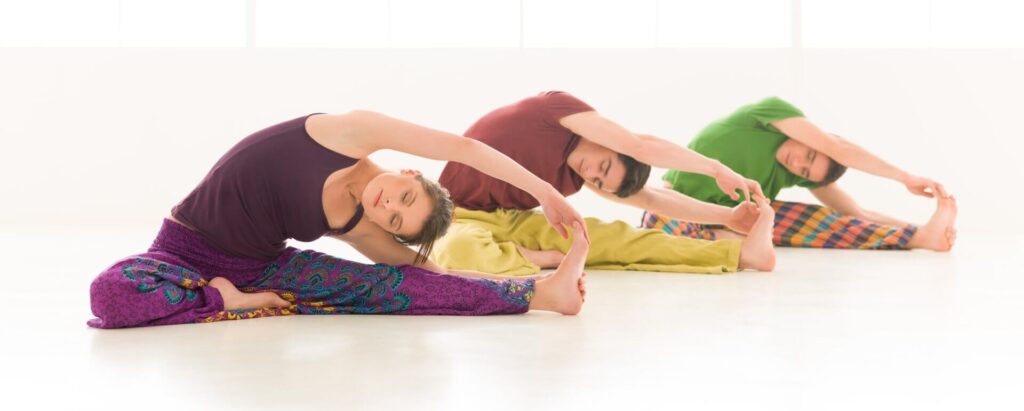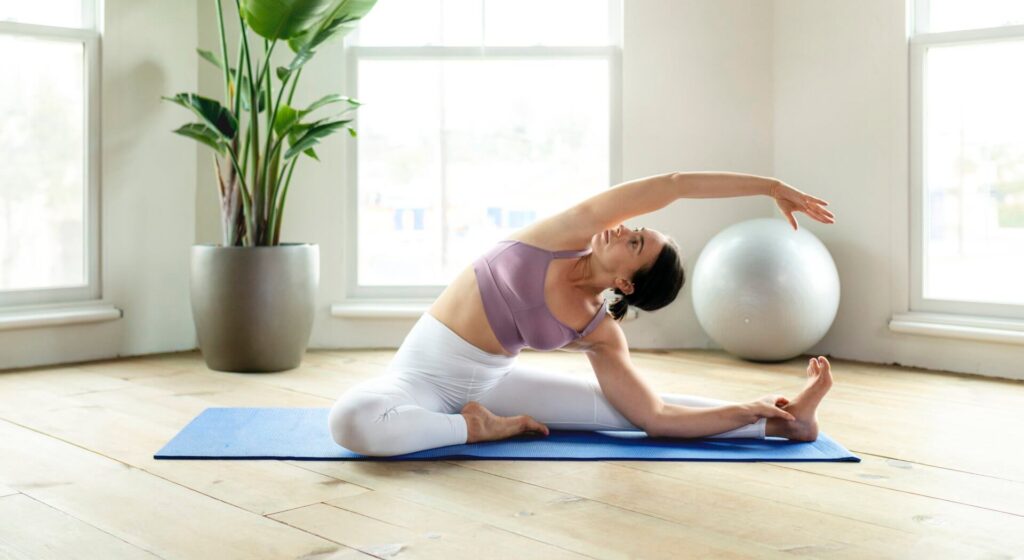“Find harmony and introspection in Parivrtta Janu Sirsasana, as you twist and stretch, connecting with your inner wisdom.”
Head-to-Knee Pose Revolved, or Parivrtta Janu Sirsasana in Sanskrit, is an intermediate-level yoga pose that offers a profound combination of spinal rotation, forward bending, and balance. In this asana, practitioners twist their torso while folding forward with one leg extended and the other bent. Parivrtta Janu Sirsasana challenges both strength and flexibility, making it a valuable addition to an intermediate yoga practice. This pose is particularly effective in stretching the hamstrings, releasing tension in the lower back, and promoting spinal health. Discover the proper alignment and techniques in this comprehensive guide, and explore how Head-to-Knee Pose Revolved can help you advance your yoga practice while fostering a deeper connection to your body and breath.
Meaning of Parivrtta Janu Sirsasana
Though not as ancient as some of yoga’s foundational poses, Revolved Head-to-Knee Pose embodies the essence of unity and balance. It encapsulates the idea that by twisting and turning, both in our physical practice and life’s journey, we can find alignment and harmony.
Parivrtta Janu Sirsasana Benefits
- Spinal Flexibility: This pose gently stretches the spine, fostering greater flexibility and mobility.
- Digestive Aid: Parivrtta Janu Sirsasana stimulates the abdominal organs, potentially aiding digestion.
- Hip and Groin Release: It offers a deep stretch to the hips and groin, releasing tension often stored in these areas.
- Mental Calm: The twist aspect of this pose is known to have a calming effect on the mind, helping reduce stress and anxiety.
How to do Parivrtta Janu Sirsasana

Follow these steps to practice Revolved Head-to-Knee – Parivrtta Janu Sirsasana yoga pose:
- Seated Base: Begin in a seated position on your mat, legs extended straight.
- Bend Your Right Knee: Bend your right knee and bring the sole of your right foot to your left inner thigh.
- Inhale: Inhale, extending your arms upward.
- Exhale and Twist: Exhale as you twist your torso to the left, bringing your left hand to the outside of your right thigh and your right hand behind you.
- Engage Your Core: Engage your core muscles, and use each inhale to lengthen your spine and each exhale to deepen the twist.
- Gaze Behind: Turn your head and gaze over your right shoulder.
- Hold and Breathe: Stay in this pose for 30 seconds to a minute, maintaining even and deep breaths.
- Repeat on the Other Side: Release the twist and repeat the pose on the other side, bending your left knee and twisting to the right.
Difficulty Level and Duration

Revolved Head-to-Knee Pose is considered an intermediate-level yoga asana due to its combination of flexibility and balance. Beginners should approach it with patience, holding the pose for shorter durations and gradually increasing as they become more comfortable.
Alternative Poses
- Half Bound Lotus Seated Forward Bend (Ardha Baddha Padma Paschimottanasana): This advanced variation combines a twist with a hip opening and forward bend, making it a challenging alternative to Parivrtta Janu Sirsasana. Sit with one leg extended and the other foot in Half Lotus position (foot on the opposite thigh). Twist your upper body to face the Half Lotus leg, then reach your opposite hand to the outside of the Half Lotus foot. Fold forward from the hips. This pose requires both flexibility and balance.
- Revolved Triangle Pose (Parivrtta Trikonasana): Parivrtta Trikonasana is a standing twist that complements the seated twist of Parivrtta Janu Sirsasana. It strengthens the legs and enhances spinal flexibility. Start in a standing position, step one foot back and turn it 90 degrees. Extend your arms out to the sides, parallel to the ground. Twist your upper body to face the front leg and reach your opposite hand to the outside of the front foot. This pose offers a different dynamic to the twist while improving balance and strength.
Yoga Music
To elevate your practice of Parivrtta Janu Sirsasana during a yoga session, consider the harmonious influence of Yoga Music. The soothing melodies and rhythmic tunes can create a serene and focused ambiance, helping you maintain mindfulness and grace in this intricate pose. As you embrace the twist and bend of this asana, the right choice of yoga music can deepen your breath, reduce stress, and enhance your connection with your posture. Whether you’re an intermediate practitioner looking to advance your practice or seeking a more profound experience, pairing Parivrtta Janu Sirsasana with yoga music can enrich your session, making it a more enjoyable yoga session.
Parivrtta Janu Sirsasana With Healing Crystals
Gemstones can enhance the experience of Revolved Head-to-Knee Pose (Parivrtta Janu Sirsasana) by providing emotional support, balance, and empowerment. Incorporating these gemstones into your practice can help intermediate yogis deepen their connection with the pose’s physical and energetic aspects, supporting alignment and intention.

- Labradorite (or Moonstone): Labradorite enhances intuition and balance in Revolved Head-to-Knee Pose, making it an ideal companion for intermediate practitioners. Moonstone also provides balance and fluidity, assisting in the graceful transitions of this pose.
- Rose Quartz (or Green Aventurine): Rose Quartz encourages love and serenity in Parivrtta Janu Sirsasana, aligning with the heart-centered nature of the pose. Green Aventurine offers heart-centered alignment and tranquility, fostering a harmonious practice.
- Blue Lace Agate (or Angelite): Blue Lace Agate promotes calm communication and balance in the revolved variation of Head-to-Knee Pose, assisting intermediate yogis in finding equilibrium within the posture. Angelite also encourages peaceful energy and emotional harmony during the stretch.
- Citrine (or Sunstone): Citrine offers energy and motivation, empowering intermediate yogis to deepen their practice and explore the full range of motion in Revolved Head-to-Knee Pose. Sunstone provides a similar invigorating energy for enhanced empowerment.
FAQ Parivrtta Janu Sirsasana
-
What muscles do Janu Sirsasana work?
Janu Sirsasana primarily works the following muscles:
Hamstrings
Quadriceps
Gluteus maximus
Adductor Magnus
Gastrocnemius
Soleus
Erector spinae
Rectus abdominis
ObliquesNote: It is always recommended to consult a certified yoga instructor for proper guidance and alignment during the practice of yoga poses.
-
How to do Janu Sirsasana step by step?
Sit on the floor with your legs extended in front of you. Bend your right knee and place the sole of your right foot against your left inner thigh. Inhale and raise both arms above your head. Exhale and bend forward from your hip joints, reaching towards your left foot with your hands. Hold this position for a few breaths. Inhale and slowly come back up to a seated position. Repeat on the other side.
-
What is the Sanskrit for revolved head-to-knee pose?
Parivrtta Janu Sirsasana.
-
What is the difference between Mahamudra and Janu Sirsasana?
Mahamudra is a meditation practice in the Tibetan Buddhist tradition that involves specific hand gestures and physical postures. Janu Sirsasana, on the other hand, is a seated yoga pose that stretches the hamstrings and lower back.


